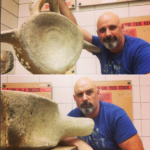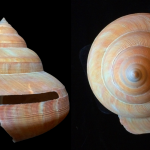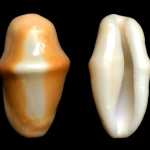All snails and their ancestors, the Gastropods, share a common feature. We people with fancy Ph.D.’s in biology call this a synapomorphy, a word derived from the Greek words for “together with”, “away from”, and “shape”, namely syn, apo, and morphe. You might think the shell is a common feature of snails, but Gastropoda also includes the slugs those slimy little monsters without shelly homes. No the common feature is a sort of an anatomical do-si-do Gastropods play with their bodies.
At beginning of a Gastropod’s life, at the tiny larval stage (the veliger), the parts of the body begin to rotate. Not of all them, just the organs for digestion, reproduction, circulation, the shell, and the body wall that covers the former and secretes the latter, twist 180˚ counter clockwise. This process, called torsion, eventually places the organs previously on the right side on the left. The central nervous system becomes a pretzel. Torsion quite literally ties the snail’s stomach in knots with the whole gut eventually twisted into a U-shape. This gut spin also has the unfortunate consequence of placing the anus right above the snail’s head in proximity way to close to the gills.

Why evolution has favored this round robin of body parts in Gastropods, and how exactly it occurs is a fascinating story and one not yet fully understood. In 1929, Walter Garstang, proposed a hypothesis both for how and why torsion occurs. Garstang was born in 1868 in England and ascended the ranks of academia to work on everything from slugs to sand crabs to sea gulls. His life’s work is divided into three periods: the first occupied primarily with pure marine biology and larval development; a second devoted to fishery investigation of which he is pioneer; and third as full professor and into retirement concentrated on fundamental problems in zoology and evolution with ventures into bird song. As noted in his obituary, in 1949, he was a poet and lover of nature. And although noted for many things, Walter Garstang, is probably best remembered for his poems about form, function, and development in invertebrates. A collection of his poems was published two years after his death as Larval Forms and Other Zoological Verses, an epic volume that resides in a special spot on my and other zoologist’s bookshelves.
In a poem about Tunicates or sea squirts, Oikopleura, Jelly Builder, Garstang waxes poetically,
A filter in front collects all the fine particles
Micro-flagellates and similar articles
Which pour in a stream through a jelly-built tunnel
Into its mouth and its mucillage funnel.
However best known among his prose is The Ballad of the Veliger or How the Gastropod Got Its Twist, a 400 word poem dedicated to and explaining torsion in Gastropods.
The Veliger’s a lively tar, the liveliest afloat,
A whirling wheel on either side propels his little boat;
But when the danger signal warns his bustling submarine,
He stops the engine, shuts the port, and drops below unseen.
He’s witnessed several changes in pelagic motor-craft;
The first he sailed was just a tub, with a tiny cabin aft.
An Archi-mollusk fashioned it, according to his kind –
He’d always stowed his gills and things in a mantle-sac behind.
Young Archi-mollusks went to sea with nothing but a velum –
A sort of autocycling hoop, instead of pram – to wheel ’em;
And, spinning round, they one by one acquired parental features,
A shell above, a foot below – the queerest little creatures.
But when by chance they brushed against their neighbours in the briny,
Coelenterates with stinging threads and Arthropods so spiny,
By one weak spot betrayed, alas, they fell an easy prey –
Their soft preoral lobes in front could not be tucked away!
Their feet, you see, amidships, next the cuddy-hole abaft,
Drew in at once, and left their heads exposed to every shaft.
So Archi-mollusks dwindled, and the race was sinking fast,
When by the merest accident salvation came at last.
A fleet of fry turned out one day, eventful in the sequel,
Whose head-and-foot retractors on the two sides were unequal:
Their starboard halliards fixed astern ran only to the head,
While those aport were set abeam and served the foot instead.
Predaceous foes, still drifting by in numbers unabated,
Were baffled now by tactics which their dining plans frustrated.
Their prey upon alarm collapsed, but promptly turned about,
With tender morsel safe within and the horny foot without!
This manoeuvre (vide Lamarck) speeded up with repetition,
Until the parts affected gained a rhythmical condition,
And torsion, needing now no more a stimulating stab,
Will take its predetermined course in a watchglass in the lab.
In this way, then, the Veliger, triumphantly askew,
Acquired his cabin for’ard, holding all his sailing crew–
A Trochosphere in armour cased, with a foot to work the hatch,
And double screws to drive ahead with smartness and dispatch.
But when the first new Veligers came home again to shore,
And settled down as Gastropods with mantle-sac afore,
The Archi-mollusk sought a cleft, his shame and grief to hide,
Crunched horribly his horny teeth, gave up the ghost, and died.
Garstang’s hypothesis about Torsion was that it occurs in two steps. The veliger possesses two retractor muscles. One of these extends from the shell on right, over the gut, and attaches to the left side of head and foot. The other starts on the left and attaches to the right. Garstang proposed that these muscles were asymmetrical in their size and strength. The right-to-left retractor causes the larval shell to twist the first 90˚ in a matter of minutes. The second 90˚ requires deferential cellular growth to accomplish. Garstang suggested further that torsion was an adaptation for protection. Without torsion, larval snails would retract into the shell tail first leaving the head and other important parts exposed to the teeth, claws, and tentacles of hungry predators. With torsion, larval snails would retract the head first. And in the grand coup d’état that was characteristic of so many of Garstang’s bold evolutionary hypotheses he offered one additional item. That evolution of no torsion to torsion all occurred through a single, not an accumulated set, of mutations.
Over 80 years later, what has happened to Garstang’s Torsion Hypothesis?
As one author put it 1958 “more controversy has been devoted to the adaptive explanation [of torsion] than to any other point to of molluscan biology.” (Morton 1958) More recently in 1992 another author noted that torsion is still one of the “grand traditional controversies among malacologists [that] have not been resolved.” (Beiler 1982)
Much like a snail, the story of understanding their past, is also full of twists. Walter Garstang himself is both praised and belittled. “He often appropriated the ideas of others without attribution, ignored earlier studies conflicting with his theories, and clung to [outdated scientific ideas]” (Holland 2011). Indeed, Garstang’s Torsion idea and others, may largely live on “chiefly though their perpetuation in numerous textbooks” (Gee 1989) and their importance colored by obituaries and commentaries on his work written by his son-in-law. As Stephen J. Gould wrote, “We cannot blame a man very strongly for lavishing too much praise on his father-in-law.” Alternative hypotheses, including one that requires a land dwelling octopus, have come and gone, and in rarer cases stayed only after dueling with the Garstang’s ghost.
Check in next week for Part 2!






Could you please post the references?
The topic is really interesting and I’d like to look up some of the papers.
Thx & Cheers
Fascinating article (like all the other ones on this site), and the poetry is very clever and amusing.